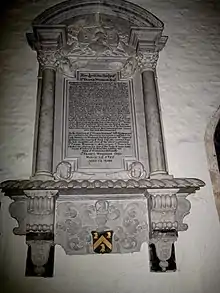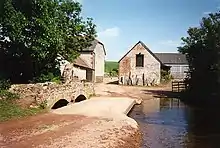Sir Francis Wyndham, 1st Baronet
Sir Francis Wyndham, 1st Baronet (c. 1612 – 15 July 1676) of Trent in Somerset (now in Dorset) was an English soldier and politician who sat in the House of Commons of England in 1640. He was a colonel of horse in the Royalist army in the English Civil War and helped Charles II escape to France.
Sir Francis Wyndham | |
|---|---|
 Wyndham Memorial, St Andrews church; erected in 1715 Trent, Dorset | |
| MP for Milborne Port | |
| In office April 1661 – July 1676 † | |
| Deputy Lieutenant of Somerset | |
| In office 1666 – 1676 † | |
| MP for Minehead | |
| In office 1640 – Suspended 1642 | |
| Personal details | |
| Born | circa 1610 Kentsford House,[lower-alpha 1] Somerset |
| Died | July 15, 1676 (aged 66) Trent Manor House, Dorset |
| Resting place | St Andrews, Trent [2] |
| Nationality | English |
| Spouse(s) | Anne Gerard (died 1653) |
| Relations | Edmund Wyndham |
| Children | Two sons, three daughters |
| Parents | Sir Thomas Wyndham (1570-1631), Elizabeth Coningsby (died 1635) |
| Alma mater | University of Padua |
| Occupation | Landowner |
| Military service | |
| Allegiance | |
| Years of service | 1642 to 1646 |
| Rank | Colonel |
| Commands | Governor of Dunster Castle 1643-1646 |
| Battles/wars | First English Civil War |
Biography

Francis Wyndham was born around 1610, fifth surviving son of Sir Thomas Wyndham (1570-1631), and his wife Elizabeth Coningsby (died 1635). His father came from the Kentsford Wyndhams, a cadet branch of the Orchard Wyndhams, a numerous and powerful grouping within the Somerset gentry. He was one of five sons, including Edmund Wyndham (1600-1681); the other three died during the 1638 to 1651 Wars of the Three Kingdoms.[3]
In 1646, he married Anne Gerard, daughter and heir of Thomas Gerard (1593-1634), owner of Trent Manor, then in Somerset, now in Dorset. They had three sons, Thomas (1648-1691), Francis (1654-1716), and Gerard.[4]
Career
In April 1640, Wyndham was elected Member of Parliament for Minehead in the Short Parliament.[5] Wyndham became a colonel in the army of Charles I and was governor of Dunster Castle. In 1645 he was engaged in the defence of Bridgwater. After the Battle of Worcester in 1651, Wyndham was instrumental in the escape of Charles II to France, hiding him in his house at Trent, Dorset for several days.[6]
In August 1660, he was elected MP for Milbourne Port in the Convention Parliament, then re-elected in 1661 for the Cavalier Parliament where he sat until his death.[5] In 1661, he was commissioned a major in the Royal Horse Guards, commanding a troop.[7]
He was created a baronet on 18 November 1673, apparently in return for foregoing a claim on the Exchequer for £10,800 granted in 1670.[5] He died three years later at the age of 64, and was buried in St Andrews' parish church, Trent. [2]
Notes
- Kentsford Farm lies in a valley beside the Washford river on the extreme western edge of the parish. It is of two storeys with attics on an irregular L- shaped plan. The west wing, facing the river, may retain the plan of a late medieval house. It appears to have been largely rebuilt c. 1600 when it became the cross wing to a hall range running eastwards and entered by opposing doorways with a porch on the south. Further alterations seem to have taken place in the late 17th century when a kitchen fireplace was put into the south room of the cross wing, and the room beyond the entrance passage was made into a parlour.[1]
References
- British History Online.
- Sir Francis Wyndham 1610-1676.
- Hughes 1830, pp. 339-342.
- Burke, Burke 1841, p. 588.
- Helms, Cassidy 2010.
- Hughes 1830, pp. 344-345.
- Dalton 1892, p. 5.
Sources
- Burke, John; Burke, Bernard (1841). A Genealogical and Heraldic History of the Extinct and Dormant Baronetcies of England, Scotland and Ireland. John Russell.CS1 maint: ref=harv (link)
- Dalton, Charles (1892). English Army Lists and Commission Registers, 1661–1714, Volume I. Eyre & Spottiswode.CS1 maint: ref=harv (link)
- "Sir Francis Wyndham 1610-1676". Findagrave.com.CS1 maint: ref=harv (link)
- Helms, MW; Cassidy, Irene (1983). WYNDHAM, Francis (c.1610-76), of Trent, Somerset, and Pall Mall, Westminster in The History of Parliament: the House of Commons 1660–1690 (Online ed.). CUP. ISBN 978-1107002258.CS1 maint: ref=harv (link)
- Hughes, John (1830). The Boscobel Tracts; the escape of Charles II after the Battle of Worcester. Blackwood & Cadell.CS1 maint: ref=harv (link)
| Parliament of England | ||
|---|---|---|
| Preceded by Parliament suspended since 1629 |
Member of Parliament for Minehead 1640 With: Alexander Popham Arthur Duck |
Succeeded by Alexander Luttrell Sir Francis Popham |
| Baronetage of England | ||
| New creation | Baronet (of Trent, Somerset) 1673–1676 |
Succeeded by Thomas Wyndham |